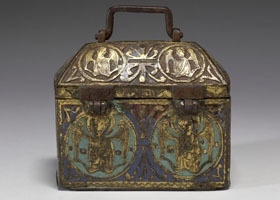
Oil in Church
Oil is used in Church in two ways: we sometimes burn it in votive lamps, and we anoint people with it. In both cases its use can be traced back to the earliest times. In the Old Testament we read of prophets and kings being annointed with oil, while in the New, we see oil being used to on one who is both–Jesus Christ.
The Christian Church adopted the use of oil from both Jewish and pagan practice very early in its history. While anointing with oil largely fell from favour in the Church of England at the time of the Reformation, its use was restored in the nineteenth century.
The importance of oil in the Anglican Catholic Church is without question, and it has its proper place in the Sacraments of Baptism, Confirmation, Unction (or the anointing of the sick) and in the Ordination of priests, It is also used at the Consecration of Bishops and in the Solemn Consecration of certain items set apart for worship, such as Altars.
Sacramental Oil
Oil as a symbol reminds us of God’s boundless generosity towards us, and of His never-ending love of us. When we use it to anoint people in Church, it is more than merely a symbol, or reminder. It becomes one of the channels by which God’s power comes into the world, by which He blesses us with His Holy Spirit.
The oil is essentially no different from any other olive oil, but it is made special by being set aside specially for God’s purposes. God takes the ordinary things of this world, in this case olive oil, and makes them holy. He works through material things to show Himself to the world and to bring people back to Himself.
In particular, three different oils used for anointing are specially blessed for this purpose by the Bishop at the Chrism Mass on Maundy Thursday, so called because one of the oils used is called ‘Chrism.’ Their names are as follows:
The oil of the sick: In the letter of St. James (5:14) we read, 「Is any among you sick? Let him call for the elders of the church, and let them pray over him, anointing him with oil in the name of the Lord, and the Lord will raise him up.」 The rite of anointing the sick in mind or body, those about to undergo surgery, those nearing death, is one of God’s gifts available to His people through His priests. This kind of anointing is itself a Sacrament. Those who receive it can be confident that God will respond to the prayer of faith.
The oil of catechumens: A ‘catechumen’ is somebody who is preparing to become a Christian, and so this oil is used to accompany the Rite of Baptism. When used, anointing at Baptism is a symbol which points to the gift of the Holy Spirit, which comes to the newly baptized person as it did upon Christ at His Baptism in the Jordan. In Baptism we are 「born of water and the Spirit」 (John 3:5), the Holy Spirit which is the gift of Christ to His Church. This anointing also reminds us at Baptism that we are made inheritors of the Kingdom of God. Sometimes the head of the person is anointed with the oil of Chrism
The Holy Chrism: Holy Chrism is the oil used to anoint people at their Confirmation, and is also used to anoint priests at their ordination. It is also used in the consecration of altars and Church buildings. In the ACC it is additionally used by bishops when they consecrate chalices and patens. ‘Consecration’ means making holy or setting apart for God’s purposes. It differs from the other two oils in that it alone is not pure olive oil. A scented balsam is mixed with the oil to make the Chrism.
How the Oil is Used
The oil is almost always applied using the right thumb, or occasionally is poured on. When applied with the thumb, it is usually applied in the form of a cross. This is to remind us that all blessing come from the crucified Christ, the source of all healing and life for the world. When anointing accompanies Baptism, the cross is marked in oil on the baptized person’s forehead. In this way they are ‘sealed’ with the Holy Spirit as a reminder of Revelation 7:3 in which the servants of God are 「sealed upon their foreheads」.
In Baptism we are made servants of God. Confirmation candidates and the sick are anointed in the same way on their foreheads, and for the same reasons. The sick are also anointed, as the need arises, on the infected part of their bodies. In this way their prayer is acted out. In the Sacraments of Confirmation and Ordination the anointing is in addition to the action of ‘Laying-on of Hands’. In the Sacrament of Unction the anointing with prayer is at the heart of the rite, and although accompanied by the ‘Laying-on of Hands’, is itself the essential element.
As with all things Christian, God chooses the ordinary things of this world, and by His Grace makes them extra-special. He then uses them to make His presence felt in the world. His does this when through the Holy Water of the Font He gives new and eternal life to His people. His does this supremely when He takes the bread and wine at the hands of a priest and returns them as the Body and Blood of Christ. He does this when, by the means of Holy Oils, he pours his healing and life giving spirit into the Church and upon her members.